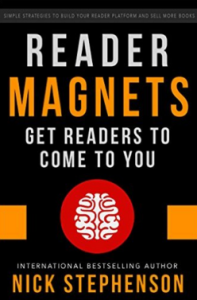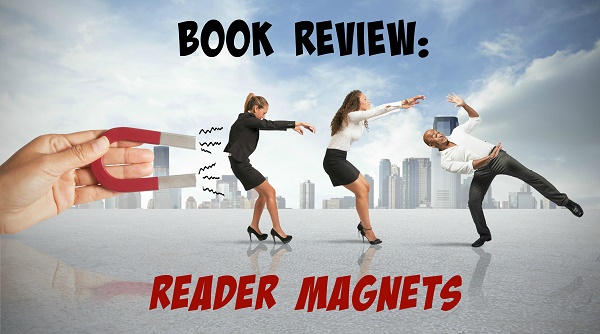Book review: Reader Magnets
Reader Magnets by Nick Stephenson is a short, permanently free (perma-free) ebook that teaches fiction authors how to build an email list.
That doesn’t mean that nonfiction authors can’t learn from it, though. It just means that if you write nonfiction, you’ll have to fill in a few blanks on your own. (More on that later.)
Use free books as reader magnets
The premise behind the book is that fiction writers can attract the right readers to their email lists by giving away their first book, which contains a link to a page on the author’s website where the reader can download a second book for free in exchange for providing their email address.
It seems that the detailed instructions provided in this 50-page book apply to fiction authors who have written at least two books. Because of that, it would be easy to conclude that the advice in Reader Magnets won’t help a novelist writing that first book, or who has written just one book so far.
But that’s not the case.
Approach this strategy with an open mind and creativity, and you will see that you can still use Stephenson’s approach and helpful how-to information with different “ethical bribes” to get readers on your list. Instead of offering a free e-book, offer a short story, novella, printable illustrations from a children’s book, and so on.
What do you have in your files already that will give readers a sample of your storytelling skills?
If you write nonfiction
If you write nonfiction and have authored just one book — and perhaps don’t intend to write another — you can use other content for your ethical bribe. Consider offering a collection of blog posts on a specific topic or a special report, checklist, template, audio interview, demonstration video, and so on.
 Here’s what I really like about this book: Stephenson shows you how to do it with screenshots and detailed instructions. While most content of this sort says, “Create an account with Mailchimp and follow the instructions to add a template to your site and create a list,” expecting you to figure out the specifics on your own, Stephenson says, “Here’s what you will see on your screen when you take this step.”
Here’s what I really like about this book: Stephenson shows you how to do it with screenshots and detailed instructions. While most content of this sort says, “Create an account with Mailchimp and follow the instructions to add a template to your site and create a list,” expecting you to figure out the specifics on your own, Stephenson says, “Here’s what you will see on your screen when you take this step.”
He explains how to set up what’s called a “landing page,” a web page with a single purpose: to offer that reader magnet in exchange for an email address.
Using Mailchimp as an email list management service example, he shows how to set up your email system.
Finally, he explains what to send to your mailing list, and when, so that you stay in touch with readers in a way that’s rewarding for both them and you.
Naturally, because this book is just 50 pages, it isn’t the only resource you’ll ever need to truly understand email marketing best practices or landing page design. Still, it offers enough details and specifics to get you up and running while you learn more.
I recommend it for any author of fiction or nonfiction who understands the importance of email marketing to book sales and author success.
Have you started building an email list?
Like what you’re reading? Get it delivered to your inbox every week by subscribing to the free Build Book Buzz newsletter. You’ll also get my free “Top 5 Free Book Promotion Resources” cheat sheet immediately!


Thank you, Sandra, for alerting us to useful material like this. I appreciate your taking time to read, review and re-purpose this e-book for non-fiction writers who are just starting out–like me. Your help speeds up my learning process. Thanks!
I’m so glad it was helpful, Karen! Thanks for letting me know. This is how online marketers build their lists, and the approach applies to all authors, too.
Sandy
Thank you Sandra! We at Tendril Press trust and respect your recommendations and always pass them on to our authors so they too can benefit from your valuable coaching. We’ve gotten our copy and can’t wait to get started.
Thanks, Karin. It’s always nice to hear from you! I’m glad it was useful.
Sandy
Thank you, Sandra. It’s always nice to get a recommendation for a free book.
You’re welcome, Julaina.
Sandy
Sandra, thank you for sharing your review. It’s a good resource for authors. I have three (3) non-fiction eBooks.
I’m glad it was helpful, Alma. I hope it gets you thinking about your options. Thanks for letting me know.
Sandy
I have had a non-fiction (how to write memoir) perma-free book on Amazon since July. Since August it has had a prominent mention of another free book (a short memoir) on my site. When people click on the link, they get to a landing page that asked them where they want to book sent. They are also told they will receive a bonus of a newsletter and other resources. To date, I have had hundreds of downloads of the perma-free book on Amazon and only one request for the second book. It’s possible people are not reading to the end. It’s possible they have not liked it enough to ask for another. It’s possible they would prefer another how-to to my short memoir. This third possibility is easy enough to correct.And what else is possible? Any ideas?
Denis, my guess is that you’re making an apples to oranges offer. They’ve downloaded a how-to book and you’re offering them a memoir — 2 different types of books. While I understand why you did that — your how-to is about how to write a memoir — people who are in information-gathering mode aren’t necessarily ready to read an example of the end product.
Also, whatever offer you use, put it in both the front and back of the book. That eliminates the “didn’t read to the end” possibility.
Sandy
What would you suggest for authors who are not self-published, and who would have to purchase their own book from their publisher in order to give it away free?
It’s hard to answer that question definitively without more information — for example, you might not be in a position where giving a book away even makes sense. But presuming it does, here are ideas from the post that eliminate that problem:
“Approach this strategy with an open mind and creativity, and you will see that you can still use Stephenson’s approach and helpful how-to information with different “ethical bribes” to get readers on your list. Instead of offering a free e-book, offer a short story, novella, printable illustrations from a children’s book, and so on.
What do you have in your files already that will give readers a sample of your storytelling skills?”
Sandy